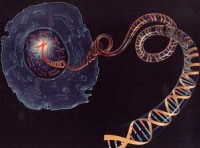-

Gold Starter Pack
1 438,00 € 1 468,00 €
-
Ta-65 on TV Fox 5 channel
2018/02/16 -

-

Why are telomeres important?
2017/02/13 -

What is telomerase?
2017/02/13
Telomeres
Publié le 2016/04/11
Telomeres are essential factors located at the ends of chromosomes (from the Greek: telos meaning ‘end’ and meros meaning ‘part’) that are required for chromosome-end protection and genomic stability. They are made up of short tandem repeats rich in G–C base pairs that may differ in sequences across different species. The 3′-overhang, which is rich in guanine sequences and known as the G-overhang, is required for folding into secondary structures such as t-loops that function to protect ends of chromosomes from being recognized as DNA damage. It is also required for telomerase extension to circumvent the end-replication problem. Adjacent to the telomeres is the subtelomeric region that is composed of highly polymorphic repetitive DNA sequences that may participate in gene silencing. Telomere-binding proteins, such as the Cdc13–Stn1–Ten1 (CST) complex and Rap1 in budding yeast and the shelterin complex in humans, also play a role in maintaining genome integrity by forming caps at the telomeres. Drosophila telomeres are distinctively different from those of most other eukaryotes, such that they consist of long repetitive elements called HeT-A and TART instead of G/C-rich base pairs. The great interest in telomeres and their regulation in mammals is their relevance to aging and cancer. In contrast to normal cells, cancer cells have detectable levels of telomerase; thus, they are able to elongate their telomeres, contributing to their ability to proliferate indefinitely. In addition, even in the absence of telomerase, a small fraction of cancer cells are still able to elongate their telomeres via an alternative pathway known as alternative lengthening of telomeres (ALT). Understanding telomere dynamics and telomerase activity in normal versus cancer cells may lead to novel approaches to prevent and treat cancer.
Keywords
Aging; Cancer; DNA replication; End protection; End-replication problem; Overhangs; Retrotransposon; Reverse transcription; Shelterin complex; Subtelomere; Telomerase; Telomeres
Source: http://www.sciencedirect.com/science/article/pii/B9780123749840015230



